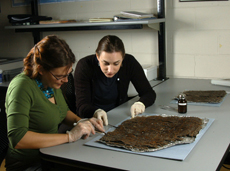|
Site numbering
Archaeological sites in the United States are identified using a three–part numbering system that was originally developed by the Smithsonian Institution. The first part of the site number identifies the state. The state identification number was determined by sorting the states alphabetically and assigning a number from 1–48. Washington was the 45th state alphabetically. Alaska and Hawaii were later added to the list. The second part of the trinomial number identifies the county in which the site is located. This is a two or three letter abbreviation. In the Biderbost site number, "SN" is the abbreviation for Snohomish County. The last part of the trinomial identifies the site. Sites are assigned sequential numbers as they are discovered within a county.
Carbon 14 dating
A scientific technique used to tell how long ago an organism lived.
Read more about Carbon 14 dating here.
Weaving techniques
In basket weaving, the warp refers to the passive, usually vertical element. The weft is the active element that intersects with the warp. The weft is usually horizontal in basket weaving.
Read more about weaving techniques here.
|

UW Museology students perform conservation treatment on Biderbost basketry
Photograph by Burke Museum
|



